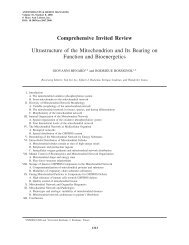MiPsummer Programme pdf - Mitochondrial Physiology Society
MiPsummer Programme pdf - Mitochondrial Physiology Society
MiPsummer Programme pdf - Mitochondrial Physiology Society
Create successful ePaper yourself
Turn your PDF publications into a flip-book with our unique Google optimized e-Paper software.
70<br />
Abstract # 39<br />
Diverse and tissue specific mitochondrial response in a mouse model of sepsis-induced<br />
multiple organ failure<br />
M. Karlsson 1 , N. Hara 2 , S. Morata 1 , F. Sjovall 1 , M. J. Hansson 1 , H. Uchino 2 , E. Elmer 1<br />
1. <strong>Mitochondrial</strong> Pathophysiology Unit, Lund University, Lund, Sweden<br />
2. Department of Anesthesiology, Tokyo Medical University, Tokyo, Japan<br />
Background The pathogenesis of sepsis-induced multiple organ failure is complex and our<br />
understanding is incomplete. It has been shown that sepsis can induce brain mitochondrial<br />
dysfunction by increased uncoupling of the oxidative phosphorylation system [1]. However we<br />
have previously demonstrated increasing respiration in human platelets during the first week of<br />
sepsis following admission to the intensive care unit [2].<br />
Objectives The objective of the present study was to evaluate the early temporal dynamics of brain<br />
and liver mitochondrial function in a mouse model of sepsis-induced multiple organ failure.<br />
Methods The ethical committee at Tokyo Medical University (H-24013) approved the study. Sepsis<br />
was induced by cecal ligation and puncture (CLP) and controls were sham operated. Using highresolution<br />
respirometry (Oroboros Oxygraph-2k) brain and liver homogenates from 31 C57BL/6<br />
mice were analyzed at either 6 h or 24 h. ROS-production was measured in brain samples using<br />
fluorometry (Oroboros LED2 module). A substrate-uncoupler-inhibitor-titration protocol examined<br />
the role of the individual complexes as well as the uncoupled maximal respiratory capacity not<br />
restricted by phosphorylation. Citrate synthase was measured in the samples as a mitochondrial<br />
marker.<br />
Results The brain exhibited an early decreased respiratory efficiency, the 6-hour group showed an<br />
increase in the LEAK state in septic mice (P = 0.037) and a trend to lower complex I function in the<br />
sepsis group (P = 0.124) resulting in a decreased respiratory control ratio (P = 0.043). At the 24-<br />
hour time point there was also a trend to lower complex I function in the sepsis group (P = 0.077)<br />
and a non-significant increase in the LEAK state (P = 0.262) resulting in a decreased respiratory<br />
control ratio<br />
(P = 0.029). There was no difference in brain ROS-production between the groups. In the liver at<br />
24-hours, there was an increased LEAK state in septic mice (P = 0,0007) as seen in brain<br />
homogenates, however complex I and complex I+II function in liver homogenates from septic mice<br />
was also increased (P = 0,0007 and P < 0.0001) compared to controls. There was no significant<br />
increase in citrate synthase activity.<br />
Conclusion The present study demonstrates a diverse and tissue specific mitochondrial response to<br />
sepsis. The brain displays an early decreased respiratory control ratio; conversely the liver showed<br />
increased OXPHOS capacity compared to controls at 24 hours. It should be noted that the liver<br />
displayed a significant difference in the control groups between time-points, perhaps due to the<br />
insult of a sham operation. This needs to be further evaluated before any final conclusions can be<br />
made.<br />
References<br />
1. d'Avila, J.C., et al., Sepsis induces brain mitochondrial dysfunction. Critical care medicine, 2008. 36(6): p.<br />
1925-32.<br />
2. Sjovall, F., et al., Temporal increase of platelet mitochondrial respiration is negatively associated with clinical<br />
outcome in patients with sepsis. Critical care, 2010. 14(6): p. R214.



